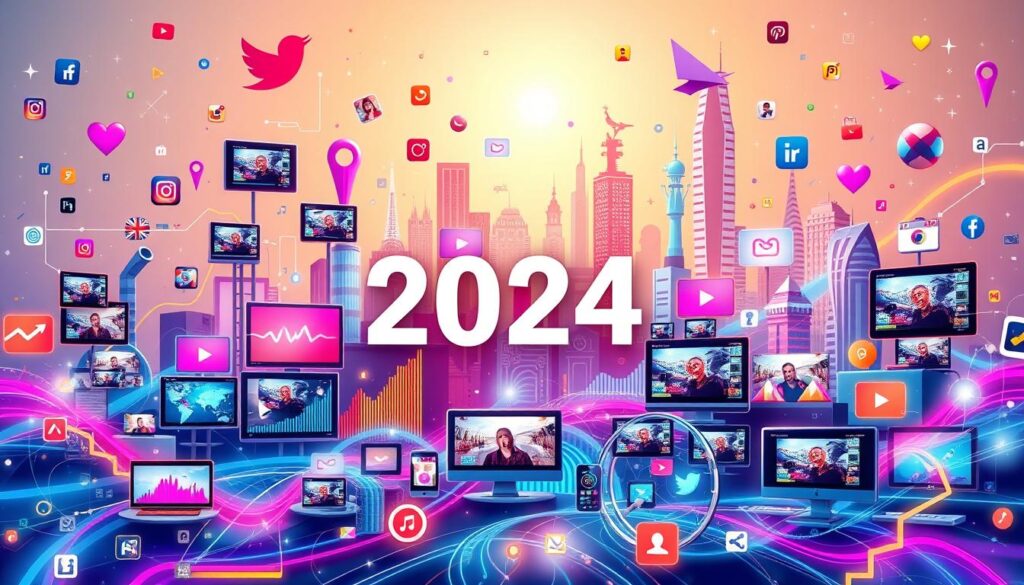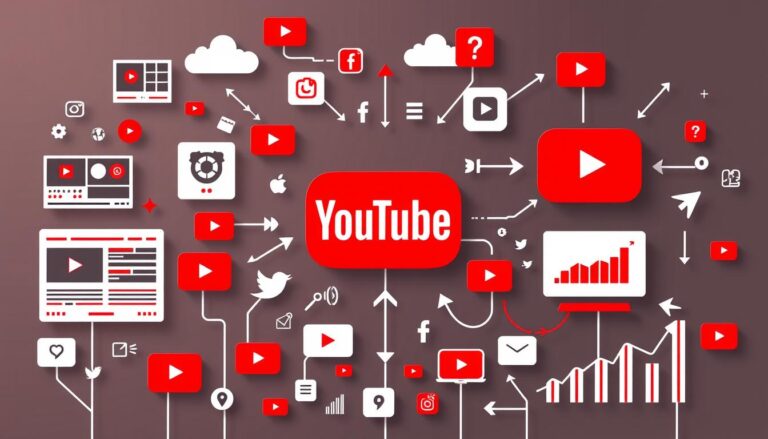Create a Winning Video Marketing Strategy
In today’s fast-paced digital world, having a strong video marketing strategy is key for brands. By 2028, people will watch digital videos for 3 hours and 30 minutes each day. This is a huge chance for businesses to reach their audience with engaging videos.
Using video marketing can help your brand stand out and connect with people. The digital video marketing industry in the U.S. is worth $135 billion. Companies see how powerful video content is in growing their business and reaching customers.
Good video marketing is more than just making videos. It’s about having a solid plan that fits your brand’s goals and knows your audience. It’s about sharing stories that people find valuable and interesting, across different platforms.
Table of Contents
Understanding the Power of Video Marketing in 2024
Digital video has changed how businesses talk to people. With new tech, making videos is key for reaching out and getting real interactions.

The world of digital is seeing a big change with video. New studies show how powerful video marketing is:
- By 2024, video will make up 82 percent of internet traffic
- Now, 86 percent of companies use video marketing
- 95 percent of people remember what they see in videos
- 55 percent watch videos every day
The Growing Dominance of Digital Video
People are watching more video than ever. The average viewer watches about 17 hours of online videos each week. This shows how engaging video can be.
“Video is no longer just an option—it’s a necessity for modern marketing strategies.”
Why Video Marketing Matters for Your Business
Video marketing brings great results. Companies that use video see big wins:
- 73% of buyers are more likely to buy after seeing a product video
- Websites with videos are 53 times more likely to be on Google’s first page
- 94% of users watch videos to learn about products or services
Current Video Marketing Trends and Statistics
The video marketing world keeps changing. Important trends include sharing videos on many platforms, making short videos, and using sites like YouTube, Instagram, TikTok, and LinkedIn to reach more people.
As how people use digital stuff changes, businesses need to update their video marketing. They must find new ways to connect with their audience.
Setting Clear Video Marketing Goals

Creating effective video marketing goals is key to your business’s success. With 96% of B2B organizations seeing video’s benefits, setting goals is essential. Your video marketing should match your business’s overall strategy to reach its full potential.
When setting video marketing goals, focus on these main objectives:
- Brand awareness expansion
- Driving conversions
- Enhancing customer retention
- Generating qualified leads
Your video marketing strategy should aim for specific, measurable results. Precision matters. For example, brands that increase their video content see a 10x return on investment.
“Video is not just content. It’s a powerful communication tool that connects directly with your audience.” – Marketing Expert
To measure success, set clear key performance indicators (KPIs):
| KPI Type | Measurement Metric | Goal |
|---|---|---|
| Engagement | View Rate | Increase by 25% |
| Conversion | Click-Through Rate | Boost by 15% |
| Brand Awareness | New Website Visitors | Grow by 30% |
Also, 89% of consumers want more video content from brands. By setting clear, achievable video marketing goals, you’ll create stories that connect with your audience.
Identifying Your Target Audience
Knowing your audience is key to a good video marketing plan. With 68% of people wanting personalized experiences, making detailed audience personas is vital. It helps you connect with your viewers.
Success in video marketing starts with knowing who you’re talking to. Only 42% of marketers really get their audience’s demographic info. This shows there’s a lot of room for better targeting.
Creating Detailed Audience Personas
Creating detailed audience personas needs careful thought. You should include:
- Demographic details (age, gender, location)
- Income levels and professional background
- Personal challenges and pain points
- Media consumption habits
- Primary online platforms
Understanding Viewer Behavior
Knowing how viewers act is crucial for content preferences. Word of mouth drives 20-50% of purchasing decisions. This shows how important it is to make videos that people want to share.
Platform Demographics Analysis
People’s preferences for platforms change with age. Younger people like Instagram and Snapchat, while older folks prefer Facebook. Knowing this helps you target better and get more engagement.
“Know your audience better than they know themselves” – Marketing Wisdom
By using advanced targeting and understanding platform behaviors, you can make your video marketing better. You’ll reach the right people at the right time.
Video Marketing Strategy Fundamentals
Creating a strong video marketing strategy means knowing how different videos fit into your buyer’s journey. It’s about being strategic and intentional. Each video should match a specific stage of customer engagement.
Planning your content is key to a solid video marketing plan. Think about these important points when you’re building your strategy:
- Match video types to specific buyer journey stages
- Create a diverse content calendar
- Develop consistent production schedules
- Align videos with overall marketing objectives
At the awareness stage, explainer videos can introduce your brand well. In the consideration phase, product demos and tutorials help people understand your solution. For the decision stage, customer testimonials and case study videos show social proof that boosts conversions.
“91.9% of users are willing to watch any type of video, with 31.3% preferring how-to videos and 29.8% interested in educational content.”
Good video content planning means knowing who watches your videos and what they like. With 82% of internet traffic being video, your strategy must be flexible and based on data.
- Analyze platform-specific audience behaviors
- Track engagement metrics
- Continuously refine your video approach
Successful video marketing is not about making lots of videos. It’s about creating targeted, high-quality content that connects with your audience at every stage of their buying journey.
Choosing the Right Video Content Types
Video marketing is a big deal in digital communication. Now, 80% of online traffic is video. Knowing the right videos can change your marketing game.
Picking the right video content is key to keeping your audience interested and converting them. Let’s look at the top video formats that can boost your brand’s story.
Explainer Videos and Product Demonstrations
Explainer videos make complex topics easy to get. They quickly show your product’s value. These videos focus on:
- Breaking down complex product features
- Showing how your solution solves problems
- Highlighting what makes your product special
Product demos give a detailed look at how your product works. 82% of consumers say videos help them decide to buy. This makes them very powerful.
Brand Stories and Customer Testimonials
Real stories build trust and connect with people. Customer testimonials are especially good, with 88% of people influenced to buy after watching a brand’s video.
“People don’t buy what you do, they buy why you do it.” – Simon Sinek
Educational and Tutorial Content
Tutorials and educational videos are very valuable. They teach skills or guide step-by-step. These videos:
- Show your brand as an expert
- Give viewers practical tips
- Keep viewers engaged
With 87% of B2B marketers using video, educational content is key in digital marketing.
Video Production Best Practices
Creating great video content means mastering key techniques. These turn simple footage into stories that grab viewers. Your visuals are key to catching eyes and sharing your brand’s message.
When making videos, aim to tell a story that speaks to your audience. Good storytelling has a clear structure:
- Introduce a relatable protagonist
- Highlight a specific customer challenge
- Demonstrate your product or service as the solution
- Provide a satisfying resolution
“Great videos don’t just show—they tell a story that connects emotionally with viewers.”
Visuals are crucial for your video’s success. Think about these important aspects:
| Visual Element | Purpose | Impact |
|---|---|---|
| Color Palette | Communicate Brand Emotion | Increases Brand Recall by 22% |
| Lighting | Create Mood and Atmosphere | Enhances Viewer Engagement |
| Location | Provide Context | Improves Narrative Authenticity |
Remember, different videos need different approaches. Explainer videos are best at 1-2 minutes, while product demos are 2-5 minutes. Make sure your video’s length keeps viewers interested and conveys your message well.
By using smart video production techniques, engaging storytelling, and careful visuals, you’ll make videos that inform and connect with your audience.
Distribution and Channel Selection
To grow your video marketing, you need to spread it across many channels. It’s not just about making great videos. It’s also about showing them to the right people at the right time.
Social Media Platform Strategy
Social media is a big chance for video marketing. With video ad spending set to hit $112.77 billion by 2028, brands must get their video strategy right.
- Facebook: Ideal for targeted demographic reach
- Instagram: Perfect for visually engaging short-form content
- TikTok: Excellent for reaching younger audiences
- YouTube: Best for longer, in-depth video content
- LinkedIn: Professional networking and B2B marketing
Website and Email Integration
Putting videos on your website can really boost engagement. Research shows adding video to a landing page can up conversion rates by up to 86%.
“Video content transforms how brands communicate with their audience, creating more meaningful connections.”
Cross-Platform Promotion Techniques
| Channel | Engagement Potential | Recommended Content Type |
|---|---|---|
| Social Media | High | Short-form, trendy videos |
| Email Campaigns | Medium | Personalized, targeted content |
| Website | High | Explainer and testimonial videos |
For cross-channel success, know each platform’s unique traits. Tailor your videos for each one. This way, you’ll reach more people and get better engagement.
Optimizing Videos for Search Engines
Mastering video SEO is key in today’s digital world. YouTube is the second-largest search engine. Knowing how to optimize your videos can greatly increase their visibility.
Starting with keyword research is essential for video SEO. Use tools like SEMrush to find the right keywords. These should match your content and what your audience wants to see.
“72% of potential buyers prefer discovering products and services through videos” – showing the power of video marketing.
Key Video SEO Optimization Strategies
- Craft compelling, keyword-rich video titles
- Create detailed video descriptions (approximately 250 words)
- Add accurate captions and transcripts
- Design engaging thumbnails
Thumbnail optimization is crucial for attracting viewers. High-quality thumbnails can boost click-through rates. This tells search engines your content is worth watching.
| SEO Element | Optimization Technique | Impact |
|---|---|---|
| Video Title | Include primary keyword | Improves search ranking |
| Description | Use relevant keywords naturally | Enhances discoverability |
| Captions | Add accurate transcripts | Increases accessibility |
Pro tip: Integrate videos with relevant web pages to drive additional traffic and engagement.
Search engines look at engagement like views, likes, and comments. Building a strong channel with quality content is vital for video SEO.
Measuring Video Marketing Success
It’s key to track your video marketing’s performance. Video analytics give insights to improve your strategy. This helps you make a bigger impact with your marketing.
Good video marketing needs to measure important KPIs. These metrics show your content’s real value. By analyzing them, you can make smart choices to boost your video marketing.
Key Performance Indicators to Track
- View count: Shows how many people see your video
- Watch time: Tells you how engaging your video is
- Play rate: Measures how interesting your video is to viewers
- Engagement rate: Tracks likes, shares, and comments
- Conversion rate: Shows how well your video drives business results
Advanced Analytics and Tracking Tools
Today’s video marketing needs advanced tracking tools. Tools like HubSpot, Wistia, and Databox help measure ROI. They go beyond just counting views.
| Tool | Key Features | Best For |
|---|---|---|
| HubSpot | CRM Integration, Detailed Analytics | Comprehensive Marketing Tracking |
| Wistia | Viewer Engagement Metrics | Detailed Video Performance Analysis |
| Databox | Custom Reporting, Real-Time Data | Advanced ROI Measurement |
ROI Assessment Methods
Figuring out video marketing’s ROI needs a smart plan. Compare the cost of making videos to the leads, conversions, and revenue they bring in.
“Data tells a story. Your job is to listen and understand what it’s saying about your video marketing efforts.” – Marketing Analytics Expert
Using real-time data with marketing tools helps you act fast. Custom reports let you focus on what matters most for your business. This keeps your video marketing strategy sharp and effective.
Leveraging AI in Video Marketing
AI is changing how businesses make, share, and improve video content. Machine learning is making video marketing smarter and more personal. It helps marketers create better video plans.
AI in video marketing has many benefits:
- Automated video production and editing
- Real-time content personalization
- Advanced audience insights
- Performance optimization
Machine learning lets you make videos that really speak to your audience. AI looks at what viewers like and how they act. This way, you can make videos that hit the mark with different groups.
“AI video technology enables businesses to create more engaging, relevant, and efficient video marketing strategies.” – Marketing Innovation Research Group
Using AI for video marketing brings big wins:
- 80% less time making videos
- Better targeting of your audience
- More relevant content
- Tracking how well your videos do in real time
| AI Video Marketing Capability | Impact |
|---|---|
| Automated Editing | Reduces production time by up to 80% |
| Personalization | Increases viewer engagement by 45% |
| Performance Analytics | Provides deeper audience insights |
Adding AI to your video marketing can open up new possibilities. The future of video marketing is intelligent, adaptive, and personalized.
Budget Planning and Resource Allocation
Creating a good video marketing budget needs careful planning and smart resource use. How you spend your money can really affect your video’s success.
When making your video marketing budget, think about these key points:
- In-house production abilities
- Options for outsourcing video making
- Costs for sharing your videos
- Investments in tech and equipment
“Smart budgeting turns video marketing into a smart investment.”
Today, businesses spend about 14% of their revenue on marketing, and video is getting more important. To save money, try these smart steps:
- Use cheap editing tools
- Make content creation scalable
- Focus on impactful video types
- Use content that works for many things
Knowing your audience and goals helps you use your video budget better. Making choices based on data helps you use your resources well and connect with people.
| Budget Category | Percentage Allocation |
|---|---|
| Video Production | 40% |
| Distribution Channels | 25% |
| Editing Software | 15% |
| Equipment | 10% |
| Training/Development | 10% |
With a smart plan for your video marketing budget, you can make engaging content. This way, you can save money and still get great results.
Conclusion
Creating a strong video marketing strategy means always learning and changing. You should be open to new tech and what your audience likes. Videos are great for sharing messages, with 95% of viewers remembering them, compared to just 10% for text.
Engaging with your audience is more than just making videos. It’s about creating experiences that really connect with them. Videos can help you build strong bonds, with 84% of people saying they’ve bought something after watching a brand video. Take the time to know what your audience wants and tell stories that interest them.
The digital world changes fast, so it’s key to keep checking how your videos are doing. Use tools to see how people are watching and reacting to your videos. The goal of video marketing is to tell real stories and offer real value, not to be perfect.
As you go on, focus on making high-quality videos that really speak to your audience. Aim for videos that match your brand’s goals and meet your viewers’ needs. By being open to change and always trying to get better, you’ll make a video marketing plan that really works.







